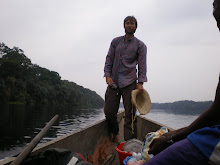Ndeli Field Station, Lomako Forest Reserve
Johnathan Kingdon is a wonderful artist. I could flip through his "Field Guide to African Mammals" for hours and in fact I have. He draws all the animals found here from elands and pangolins, mongooses, hyraxes, elephants, primates and many more. I especially like the drawings of the guenon (monkeys) faces, the upside-down bats, and the strange and beautiful dikdiks. The book makes me think of Silas and I wonder if he would like it someday. I hope so. It is a beautiful book.
The camp at Ndeli has changed immensely since my last field season here. Gone are the thatched huts and raised platforms which support and protect a tent. Gone too are the candle lit dinners and card games with headlamps. The African Wildlife Foundation (AWF) has poured what must have been a relatively large amount of money into the site. There is a big, open pavilion with a screened in mess hall. The satellite internet dish is attached to a concrete office painted yellow and crowned with corrugated tin roofs. There is running water.

There are three externally wood-paneled cabins, each named for a fruit preferred by bonobos, the primates I am studying and the main draw for potential tourists. Valentin, the AWF man in charge, is in the Linkolo cabin while Ross and India are in Bolinde house. I am in Botende- a fruit I am embarrassed to acknowledge I do not know. Amy, the fourth researcher on the trip has found herself on the outside, living in a tent under a thatch lean-to. Ross, India, Amy and myself left the US for Ndeli a week ago and after flying into Kinshasa, a sketchy interior flight, and a two-day river trip in a dug out canoe, we have just arrived.

Our collective goal is to learn more about the ecology, social behavior, genetics, and hormones of the bonobos inhabiting the forest. It is a difficult task. The forest is thick and high and the bonobos are hard to find. It is always hot and humid and there isn't a cold beer within 100 miles from here. I guess that shouldn't be a surprise to anyone living in the rainforest of equatorial Africa. Have I mentioned the bugs?

Because we can't always find or keep up with the bonobos, we often analyze the objects associated with them. They build nests every evening so I mark the tree and determine what kind it is. I measure the length, width, thickness and height of the nests (estimates from the ground). And I look for shit. Err, feces. Thats right, I collect and sift through bonobo poop in an effort to a) find out what they are eating by identifying the seeds, and b) store some of the fecal material to bring back to the states in order to identify individuals from their DNA and determine relatedness within and between different individuals, parties, and communities, all while looking for connections to our own evolution. Yes, it is the glamorous life. Sometimes I really miss drinking beer at Elk Lake on a sunny afternoon. Sometimes I am genuinely excited to sift through more bonobo shit.


Michel, I want Details. You are gone again.. by yourself??? Am I the last to know. I'll need to read more entries so I can get updated on your whereabouts!
ReplyDelete